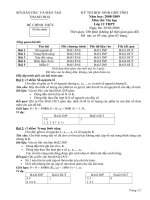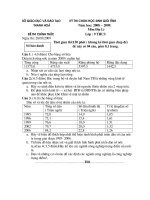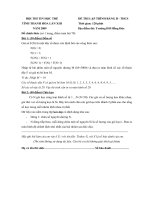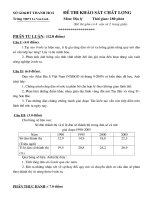- Trang chủ >>
- THPT Quốc Gia >>
- Ngoại Ngữ
DE THI HSG TINH THANH HOA 2016 2017
Bạn đang xem bản rút gọn của tài liệu. Xem và tải ngay bản đầy đủ của tài liệu tại đây (144.76 KB, 7 trang )
SỞ GIÁO DỤC VÀ ĐÀO TẠO
THANH HÓA
ĐỀ THI CHÍNH THỨC
Họ tên thí sinh: ......................................................
KÌ THI CHỌN HỌC SINH GIỎI CẤP TỈNH
Năm học: 2016 - 2017
Môn thi: Tiếng Anh
Lớp 12-THPT
Ngày thi: 10 tháng 3 năm 2017
Thời gian : 180 phút (không kể thời gian giao đề)
Đề thi này gồm có 05 trang
Phòng thi số:..........Số báo danh:.............
PART A: LISTENING (15 pts)
Part I. Complete the form below. Write NO MORE THAN TWO WORD OR A NUMBER for each answer.
(5 pts)
VIDEO LIBRARY APPLICATION FORM
Surname
Jones
First names:
Louise Cynthia
Address:
(1) ____________________ 1, 72 Black Street, Highbridge
(2) ___________________
2085
Telephone:
(3) ___________________
94561309
Driver's license number:
(4) ____________________
Date of birth:
Day: 25th Month: (5) _________________ Year: 1977
Part II. A young woman talks about recently discovering that she has a half-sister. Listen and decide
whether each of the following statements is True (T) or False (F). (5 pts)
6. Her family is quite big.
T/F
7. Her older sister is 20 years old.
T/F
8. Her half-sister is living in Germany.
T/F
9. She has never met her half-sister.
T/F
10. She has no intention of getting to know her half-sister
T/F
Part III. Listen to the passage and choose the best answer according to what you hear. (5 pts)
11. There are ________ national parks in the US.
A. 30
B. 32
C.50
D. 52
12. National parks account for ________ of the total land area of the country.
A. 3%
B. 13%
C. 30%
D. 33%
13. National parks attract ________ visitors each year.
A. billions of
B. millions of
C. a billion
D. a million
14. People cut down trees for ________ .
A. barks
B. wood
C. goods
D. other parts
15. Devasting fires in large areas of national parks are caused by ________ .
A. visitors’ vehicles
B. lack of money
C. careless people
D. the parks’ staff
PART B: VOCABULARY AND GRAMMAR (35 pts)
Question I: Choose the most suitable word or phrase to complete each sentence. (10 pts)
16. Military is_________in this country. Every man who reaches the age of 18 has to serve in the army for two
years.
A. compulsory
B. optional
C. illegal
D. unnecessary
17. In _______ most social situations, _______ informality is appreciated.
A. Ø / Ø
B. the / an
C. a / the
D. the / a
18. We have just bought _________ table.
1
1
A. an antique oval oak dining
B. an oval antique oak dining
C. an oak antique oval dining
D. a dining oval oak antique
19. Despite the financial problems, she managed to ______ her fortune.
A. hold on to
B. catch up with
C. keep back
D. carry away
20. There is a small number involved, possibly ______ a hundred.
A. as many as
B. as little as
C. as few as
D. as much as
21. ''You must have had a very good time on holiday."
"__________, it was a disaster. Everything went wrong."
A. By tradition
B. On the condition
C. In short
D. On the contrary
22. She joined the local tennis club, __________ were at least 60.
A. most of its members
B. most whose members
C. most of whose members
D. most members
23. - John: “If only I hadn’t lent him all my money.”
- Peter: “________ ”
A. I’m afraid you will have to do it.
C. Sorry, I have no idea.
B. All right. You will be OK.
D. Well, you did, so it’s no use crying over spilt milk.
24. . I was _______ the impression that I had paid you for the work you did for me.
A. on
B. for
C. under
25. He goes jogging every morning, rain or ______ .
A. sun
B. snow
C. shine
D. with
D. wind
Question II: The passage below contains 7 mistakes( from 26 to 32). Recognise the mistakes and write
their correct forms in your answer sheet. (7 pts)
Everyday life today is much more complicated than in the past. Even in our leisure time we have to
make so many choices about what to do or even what to watch on TV. We are often spoilt for choice and this
can leave us feel confused and dissatisfied. We all know that it is important to achieve a balance between
work and play but many of us do not succeed. Instead, we put extra pressure in ourselves by trying to be as
successful in our work life than in our personal life.
Life in the past was much simpler as many people worked to meet their basic needs. Today, for many
of us, our job is not just a way of make a living. For many, work plays an important role in our everyday life
and gives us strong sense of personal fulfillment. What is more, we have become much more materialistic.
Many people set them goals such as buying a new house or car and so we measure our success by the
material things we own. Desiring these luxuries is that motivates us to work much harder than in the past, so
in many ways we choose this way of life.
Question III: Put each verb in brackets into an appropriate form. (10 pts)
33. Anna admitted (surprise)_________ at the unexpected birthday party we gave her last night.
34. If you (work) ________late last night, how come I didn’t see your light on?
35.We’ll meet Linda at the corner. She (wait)_________ when we arrive.
36. John’s score is the highest in the class. He (study) ________ very hard last week.
37. There (think) ________ to be disagreements among senior ministers.
38. "The maintenance people didn't remove the chairs from the ballroom."- "Don't worry. They (move)
________ them by the time the dance begins."
39 - 40. (Leave) ________ (uncover) ________, the balcony chairs will be ruined in this weather.
41. It is the recommendation of many psychologists that a learner (use) ________ mental images to
associate words and remember names.
2
2
42. (refuse) __________ at the last time, she does not want to ask them.
Question IV: Put each word in brackets into an appropriate form. (8 pts)
43. He tried different ways of _____(SIMPLE) the grammar.
44. Low income and little administrative support make teachers _______ (HEART) with their profession.
45. The first time I tried out my new bike, I _________ (BALANCE) and fell off.
46. During the Civil War, the North’s population, __________(INDUSTRY) capacity, and financial resources
were much greater than those of the South.
47. She is one of the greatest __________( PERFORM) to appear in this theater.
48. The evening was __________ (ENJOY) spent playing cards and tallking.
49. All the _________ (OCCUPY) of the flats upstairs are expected to move out before the end of this
month.
50. It was in the 1930s and 1940s that American ______ (CONSUME) culture was consolidated.
PART C: READING COMPREHENSION (30 pts)
Question I: Read the following passage and then choose the most suitable word or phrase for each
space. (10 pts)
FAMILY HISTORY
In an age when technology is developing faster than ever before, many people are being attracted
(51) ______the idea of looking back into the past. One way they can do this is by investigating their own
family history. They can try to find out more about (52) ______ their families came from and what they did.
This is now a fast-growing hobby, especially in countries with a (53) _____ short history, like Australia and the
United State.
It is (54) _____ thing to spend some time going through a book on family history and to take the (55)
_____ to investigate your own family’s past. It is (56) _____ another to carry out the research work
successfully. It is easy to set about it in a disorganised way and (57) _____ yourself many problems which
could have been avoided with a little forward planning.
If your own family stories tell you that you are (58) _____ with a famous character, whether hero or
criminal, do not let this idea take over your research. Just (59) _____ it as an interesting possibility. A simple
system for collecting and storing your information will be adequate to start with; a more complex one may only
get in your (60) _____. The most important thing, though, is to get started. Who knows what you might find?
51. A. with
52. A. which
53. A. fairly
54. A. a
55. A. idea
56. A. quite
57. A. produce
58. A. connected
59. A. treat
60. A. track
B. to
B. when
B. greatly
B. one
B. plan
B. just
B. cause
B. joined
B. control
B. path
C. at
C. where
C. mostly
C. no
C. purpose
C. more
C. build
C. attached
C. contact
C. road
D. for
D. why
D. widely
D. some
D. decision
D. even
D. create
D. related
D. direct
D. way
Question II: Supply the most suitable word for each blank. (10 pts)
FLOWER POWER
Flower grow everywhere in the world, but when people think of tulips, they think of the Netherlands.
The Dutch have a saying: “Flowers love people”. If (61) ______ is true, then flowers really love the Dutch (62)
______ flowers have been cultivated in the Netherlands for hundreds of years. In fact, the flower industry
has been so profitable that it has been boosting the Dutch economy (63)________ the seventeenth century.
Recently, however, the Dutch flower (64)______ have been having difficulties in coping with the tough
competition from (65) ______ . The Colombians, for instance, have taken the Dutch (66) ______ surprise.
Their flowers are now (67) ______ demand all over the world due to the simplest (68) ______ that they are
3
3
cheaper. Within a few short years, the Colombians have brought Holland’s (69)______ of the flower industry
to an end.
Despite this fact, the Netherlands is still in control of over sixty per cent of the world’s flower
(70) ______ .
Question III: Read the passage and choose the best answers to questions below. (10 pts)
In today’s culture, tattoos are very popular as a form of body decoration. As seen in their prevalence
among rebellious teenagers, social outsiders, dangerous outlaws, and many other people, tattoos are
viewed as luxurious fashion statements that possess a forbidden attraction -mainly as long as they
remain unseen. However, some people get tattoos in order to identify themselves with certain groups, such
as military units, fraternities, or even criminal organizations, like the Japanese yakuza. Tattoos have been
used in this manner throughout history by many different cultures in the world. In fact, they have always been
an important functional and symbolic feature in most tribal and ancient cultures, whether they were used for
identification, worship, therapy, decoration, or in other rituals.
The earliest written records describing tattoo usage date back to Ancient Egypt, from where the
practice spread to Crete, Greece, Persia, and Arabia. However, tribal cultures throughout northern Europe,
the western hemisphere, and east Asia had been applying tattoos for several thousands of years before this,
with people in Japan reportedly creating tattoos ten thousand years ago. One of the best pieces of evidence
of this usage came from the excavation of Otzi the Ice Man, the Oldest naturally preserved body discovered
in Europe. Dating back to 3300BC, this mummy had fifty-seven tattoos on its body, mostly located on the
inside of the left knee, ankle, and legs. In China and Russia, naturally mummified bodies that are just as old
have been found to bear tattoos in similar sports. Based on the location of these tattoos, some researchers
speculate that they were part of a therapeutic treatment for bones.
Ancient and tribal cultures used tattoos primarily for identification, though. A person’s tattoo would
indicate their tribe, family, or social status. For instance, the Norse, the Danes, the Saxons, and other
Germanic peoples used tattoos to identify their particular clans. The Maori in New Zealand used tattoos to
indicate their social ranking. In many southeast Asian tribes, as well as in American tribes like the Inuit,
women used tattoos to indicate that they were eligible for marriage or already married. Tattoos were also
very common among warriors who displayed bravery or ferocity in combat. Chickasaw warriors distinguished
themselves with tattoos, and the Dayak tribes used them to boast of the people they killed in battle. In later
military usage, ancient Greek spies had tattoos that related their military ranks to each other. Originally,
Roman soldiers did not have tattoos. However, after witnessing the fierceness of British tribes they fought,
Roman soldiers began to get tattoos in order to emulate their enemy’s ferocity.
71. Which of the sentence below best expresses the essential information in the highlighted sentence in the
passage?
A. Tattoos are popular with rebellious people who like to remain unseen, like teenagers, outlaws, and
outsiders.
B. Tattoos have a rebellious attraction for many different kinds of people, but they usually must stay covered
up.
C. Tattoos are attractive to different kinds of people who want to display their rebellious instincts for everyone.
D. Tattoos are such luxurious fashion statements that only a small number of people can get them, so they’re
rarely seen.
72. In paragraph 1, the author mentions the modern use of tattoos as a form of identification in order to
A. introduce their origins in older cultures
B. explain their associations with criminals
C. provide technical details on tattoos
D. condemn them as fashion statements
73. The word "fraternities" in paragraph 1 is closest in meaning to
A. markets
B. universities
C. societies
D. stores
74. According to paragraph 2, some researchers believe that the tattoos found on mummies were used to
A. mark them as slaves
B. treat bone ailments
C. begin their adulthood
D. assist them in worship
75. Based on the information in paragraph 2, what can be inferred about the origins of tattoos?
A. All ancient cultures copied the practice from Egypt.
B. Otzi the Ice Man is the first to have ancient tattoos.
4
4
C. It took thousands of years for tattoos to be used globally.
D. Tattoos developed independently in different cultures.
76. The word “them” in paragraph 3 refers to
A. warriors
B. themselves
C. tattoos
D. tribes
77. The word "eligible" in paragraph 3 could best be replaced by
A. intelligent
B. young enough
C. trained
D. qualified
78. According to paragraph 3, why did the Roman soldiers begin to get tattoos?
A. They were inspired by the ferocity of their tattooed enemies.
B. They wanted to boast of the enemies they killed.
C. They needed to identify their military ranks.
D. They used tattoos to treat their battle wounds.
79. According to paragraph 3, all of the following are listed as things identified by tattoos in tribal cultures
EXCEPT
A. marital status
B. tribal affiliation
C. social rank
D. criminal status
80. Which of the following can be the best title of the passage?
A. Tattoos – a rebellious attraction
B. Tattoos on ancient mummies
C. Usage of tattoos as identification
D. Tattoos in tribal and ancient cultures
PART D: WRITING (20 pts)
Question I: Finish each of the following sentences in such a way that it is as similar as possible in
meaning to the sentence printed before it. (5 pts)
81. Redundancy has caused a lot of domestic problems.
Many a____________________________________________________
82. I explained what had happened but they totally refused to accept what I said.
They found ________________________________________________
83. It’s a widespread assumption that George was wrongly accused.
George ____________________________________________________
84. There is no point in waiting any longer. He’s not going to come.
It is not ___________________________________________________
85. We may as well start the meeting, now that we are all here.
As _______________________________________________________
Question II: Finish each of the following sentences in such a way that it is as similar as possible in
meaning to the sentence printed before it. Do not change the form of the given word. (5 pts)
86. By the time we arrived at the theatre, nearly all the seats had been taken.
(HARDLY)
There _________________________________________________
87. Everyone was exhausted apart from Paul.
(EXCEPTION)
With ___________________________________________________
88. If by chance you are arrested, you don’t have to say anything.
(UNDER)
If _____________________________________________________
89. The part she has played in this project mustn’t be ignored.
(BEAR)
We must _________________________________________________
90. Patrick doesn’t usually forget his appointments.
(LIKE)
It is _____________________________________________________
Question III. Essay writing (10 pts):
---------- THE END ---------
5
5
SỞ GIÁO DỤC VÀ ĐÀO TẠO
THANH HOÁ
KỲ THI CHỌN HỌC SINH GIỎI CẤP TỈNH
Năm học: 2016-2017Môn thi: Tiếng Anh
Lớp 12 THPT
Ngày thi: 10/03/2017
Hướng dẫn chấm gồm 02 trang.
HD CHẤM CHÍNH THỨC
A- ĐÁP ÁN
PART A: PHONETICS (5 điểm – Mỗi câu đúng 1 điểm)
PART B: VOCABULARY & GRAMMAR (45 điểm - Mỗi câu đúng 1 điểm)
Question I.
Question II.
WORD
LINE
WORD
LINE
Question III
Question IV
PART C: READING COMPREHENSION (30 pts)
( Mỗi câu đúng 1 điểm)
Question I
Question II.
Question III.
PART D: WRITING (20 pts)
Question I (5 điểm- Mỗi câu đúng 1 điểm)
Question II (5 điểm- Mỗi câu đúng 1 điểm)
6
6
Question III. Essay: (10 điểm)
Marking criteria:
+ Task completion (4 điểm)
Tuỳ theo khả năng hoàn thành về bố cục và những yêu cầu nội dung cho mỗi phần ( mở bài,thân bài,kết
luận) giám khảo có thể chấm từ 1 - 4 điểm.
+ Grammatical accuracy and spelling 3 điểm: bài viết không có lỗi chính tả và từ ba lỗi ngữ pháp trở
xuống được cho 3 điểm tối đa. Cứ 4 lỗi chính tả hoặc ngữ pháp trừ 1 điểm (Trừ không quá 3 điểm).
- Coherence and cohesion (tính mạch lạc và sự liên kết câu, đoạn) – 3 điểm:
Tùy mức độ mạch lạc, liên kết câu, liên kết đoạn của bài viết, giám khảo có thể chấm 1-3 điểm.
B- HƯỚNG DẪN CHẤM
Bài thi chấm theo thang điểm: 20
Điểm bài thi làm tròn đến 0,25
Tổng số điểm thí sinh làm đúng
Điểm bài thi
=
--------------------------------------5
7
7









